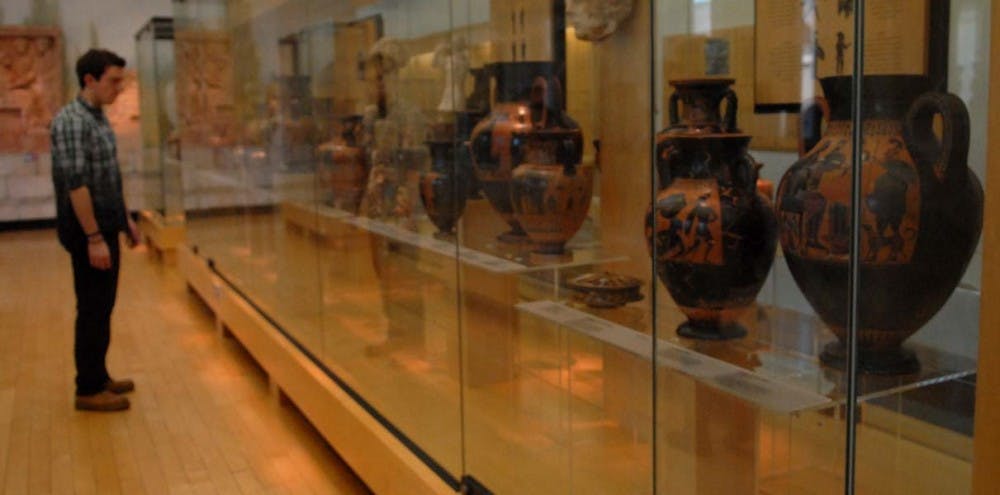
Clio, the Greek muse of history, has found her way into the Penn Museum.
She is the namesake of the Clio Society, a club at the University of Pennsylvania Museum of Archaeology and Anthropology that teaches students to be gallery guides and provides them the opportunity to become certified in leading tours.
“I really believe that museums should be open to a bunch of people, not just art history majors and not just anthropologists,” said Loa Traxler, the associate deputy director of the Penn Museum, who serves as a facilitator and guide for the Clio Society.
Every Wednesday night, the group of about 10 students gathers at the Museum to work on developing their own tours of the exhibits. The members start out by identifying objects that interest them and researching their histories, according to Traxler.
At each meeting, people then come in with about five minutes of material to discuss a specific artifact in their area of interest, College junior and Clio student organizer Brittney Joyce explained.
While the club generally attracts the interest of students in fields like classics, anthropology and art history, Traxler said that membership is not confined to just those departments.
“It’s intended to be that kind of open forum for people who have an interest but not necessarily an academic background in the things we display here,” Traxler said.
Joyce herself is an English major who joined the club to pursue her interest in ancient Egypt outside of the academic realm. “It’s a nice supplement for something I don’t really spend a lot of time on otherwise,” she said.
For those with an academic interest, however, Clio can be an additional way to explore their studies.
College senior Jesse Dubois, a member of the Clio society, said that as a classics and philosophy major, the classes he has taken eased the research process. “I don’t have to do much outside research because I’ve already learned it,” he said.
College sophomore Monica Fenton, the other student organizer of Clio, agreed that her academics have translated well to her experience with the group. “A lot of the classes I’ve taken, especially archaeology ones, use the Museum as a teaching tool during recitation,” Fenton said.
Undergraduate Chair of Classical Studies James Ker said the academic overlap is the result of a department-wide initiative that was instituted several years ago. “We made a commitment as a department that every course we teach would involve one trip to the museum,” he said.
Ker added that the relationship between Clio and related courses is a two-way street. “It makes [students] very aware of material culture, which is something that will come up in a lot of classes,” he said, and students go into the club with knowledge from their courses.
Drawing upon previous academic knowledge and other Penn Museum resources, the members of Clio have to compile their short artifact presentations into a 50-minute tour, which usually covers six to eight objects.
The members will then present their tours to the museum’s senior docent in the hopes of becoming tour-certified before Penn Preview Days, when they will first give their tours, Fenton said.
However, the tours are generally geared toward a younger demographic. In founding Clio, Catherine Krabbenschmidt said that she and Alex Olsman, both 2012 College graduates, thought, “If we could create a student docent program, we could start engaging elementary school students from West Philadelphia.”
With this in mind, Joyce said, “We’ve also had a few sessions with museum educators at the Penn Museum who’ve talked to us about how children of different ages learn, what things you should emphasize and different ways to interact with mixed age groups that come to the museum.”
The students also participate in Museum outreach events by volunteering at activities like 40 Winks with the Sphinx, a Penn Museum sleepover for local students between the ages of 6 and 12. According to Fenton, members of Clio are required to volunteer for at least three Museum events each year.
“The students who are most likely to be in Clio are also likely to be peer advisors, to go abroad to Rome or Greece and to be motivated to seek out opportunities to extend their classroom experiences,” he said. That extra level of dedication is typical of the members of Clio that Ker has known.
Those students, Traxler said, are what ultimately keep the Museum alive. “This museum lives and breathes with students who are involved here,” she said.
The Daily Pennsylvanian is an independent, student-run newspaper. Please consider making a donation to support the coverage that shapes the University. Your generosity ensures a future of strong journalism at Penn.
DonatePlease note All comments are eligible for publication in The Daily Pennsylvanian.





